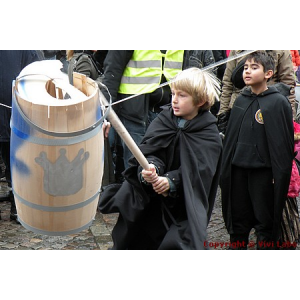 Yule or Yule-tide is a winter festival that was initially celebrated by the historical Germanic peoples as a pagan religious festival, though it was later absorbed into, and equated with, the Christian festival of Christmas. The festival was originally celebrated from late December to early January on a date determined by the lunar Germanic calendar. The festival was placed on December 25 when the Christian calendar (Julian calendar) was adopted. Some historians claim that the celebration is connected to the Wild Hunt or was influenced by Saturnalia, the Roman winter festival.
Yule or Yule-tide is a winter festival that was initially celebrated by the historical Germanic peoples as a pagan religious festival, though it was later absorbed into, and equated with, the Christian festival of Christmas. The festival was originally celebrated from late December to early January on a date determined by the lunar Germanic calendar. The festival was placed on December 25 when the Christian calendar (Julian calendar) was adopted. Some historians claim that the celebration is connected to the Wild Hunt or was influenced by Saturnalia, the Roman winter festival.
Terms with an etymological equivalent to “Yule” are still used in the Nordic Countries for the Christian Christmas, but also for other religious holidays of the season. In modern times this has gradually led to a more secular tradition under the same name as Christmas. Yule is also used to a lesser extent in English-speaking countries to refer to Christmas. Customs such as the Yule log, Yule goat, Yule boar, Yule singing, and others stem from Yule. In modern times, Yule is observed as a cultural festival and also with religious rites by some Christians and by some Neopagans.
Danes celebrate on December 24, which is called Juleaftensdag (literally, Yule Eve Day), or simply Jul. An elaborate dinner is eaten with the family in the evening, consisting of roast pork, roast duck or roast goose with potatoes, red cabbage and gravy. For dessert is rice pudding with a cherry sauce, traditionally with an almond hidden inside. The lucky finder of this almond is entitled to a small gift. After the meal is complete, the family gather around the Juletrea to sing Christmas carols and dance hand in hand around the tree. Then the children often hand out the presents which are opened immediately.
This is followed by candy, chips, various nuts, clementines, and sometimes a mulled and spiced wine with almonds and raisins called Glogg is served hot in small cups. Following the main celebration of Jul or Juleaften on December 24, December 25 and December 26 are, respectively, celebrated as Forste Juledag and Anden Juledag, both holidays, and are generally filled with relaxed familial socializing and the enjoying of leftovers from the Juleaften meal. Some Danish families also celebrate December 23 as Lillejuleaften (Little Christmas Eve). Traditions for this day might include decoration of the Juletr?, enjoying roast duck, and caroling.
Free eBooks (Can Be Downloaded):
Hellmut Ritter - Picatrix In GermanMelita Denning - The Foundations Of High Magick
Arthur Edward Waite - The Templar Orders In Freemasonry
Tommie Eriksson - Tree Cults In Northern Magic